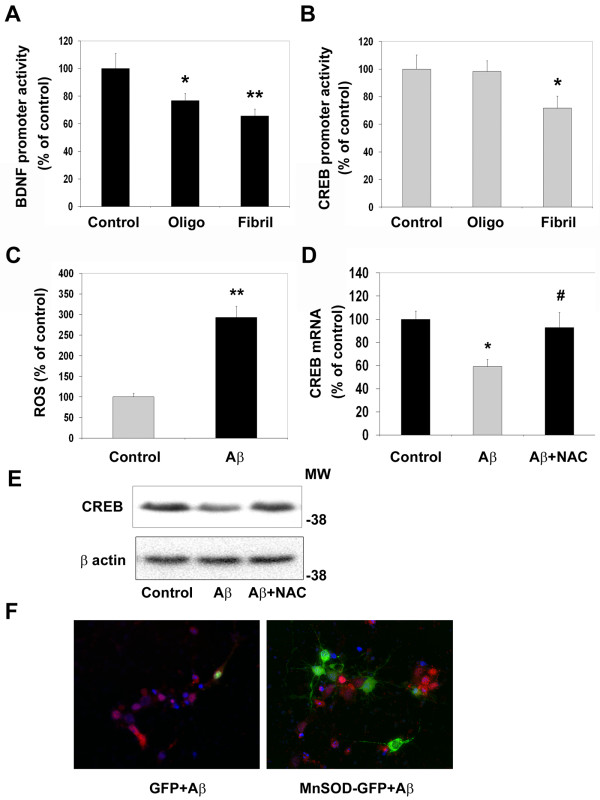Figure 7.
Effects of Aβ oligomers and fibrils on CREB expression in cultured rat hippocampal neurons. (A, B) Hippocampal neurons were transfected with luciferase reporters linked to a BDNF promoter (A) or a CREB promoter (B) with LipofectAMINE 2000 reagent. A constitutively active renilla luciferase was also included for transfection efficiency. Transfected cells were treated with Aβ oligomers or fibrils (2 μM) for 24 h. Luciferase activities were determined using dual luciferase assay kit (Promega). Oligomers decreased the activity of BDNF-promoter but not CREB promoter whereas fibrils downregulated both promoters. *p < 0.05 and **p < 0.01 compared to untreated control. (C) Intracellular oxidative stress was measured using an oxidation-sensitive dye, 5- (and 6-)-chloromethyl-2', 7'-dichlorodihydrofluorescein diacetate (CM-H2DCFDA). Rat primary hippocampal neurons were loaded with the dye and the fluorescence emitted at 535 nm was measured using the CytoFluor multiwell plate reader after exposure to Aβ fibrils (2 μM). Aβ fibrils induced significant accumulation of reactive oxygen species in neurons. **p < 0.001 vs control. (D) Neurons were exposed to Aβ fibrils (2 μM) in the presence and absence of N-acetyl cysteine (NAC; 5 mM) for 18 h. Total RNA was isolated and the levels of CREB mRNA were measured by real-time quantitative RT-PCR using a TaqMan™ fluorogenic probe. The values are mean ± SEM of four independent experiments. Aβ-induced downregulation of CREB expression was blocked by the antioxidant, N-acetyl cysteine. *p < 0.01 compared to control and #p0.01 vs Aβ. (E) Neurons were exposed to Aβ fibrils (2 μM) in the presence and absence of N-acetyl cysteine (NAC; 5 mM) for 18 h. Treated neurons were lysed and processed for the Western blot analysis of CREB and β actin. NAC restored Aβ-induced decrease in CREB protein levels. (F) Hippocampal neurons cultured on cover slips were transfected with plasmids encoding GFP or MnSOD-GFP chimeric protein (green) followed by exposure to Aβ (5 μM) for 48 h. The fixed cells were immunostained for the active cleaved fragment of Caspase-9 with Cy-3 (red) as a marker for the mitochondrial pathway of apoptosis. Examination of 20 fields each from 3 independent experiments showed that the cells expressing MnSOD (green) were resistant to Aβ-induced apoptosis.

